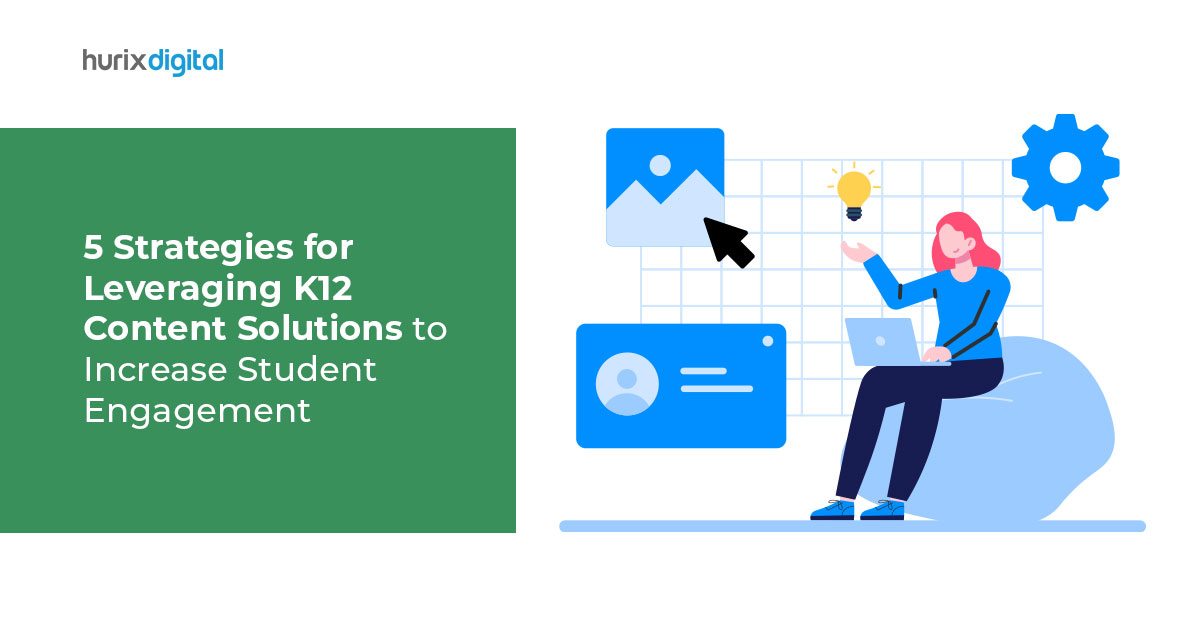
5 Strategies for Leveraging K12 Content Solutions to Increase Student Engagement
The growth of K12 content solutions has been one of the most significant advancements in recent years. According to sources, global spending on education has crossed US$4.7 trillion annually.
Student engagement is vital to the success of any educational program, and K12 content solutions can help you get there. Educators can potentially develop material that attracts students’ attention and motivates them to engage actively in their learning by employing the correct tactics and resources.
In this post, we’ll look at five techniques for using K12 content solutions to boost student engagement. These tactics are intended to assist instructors in creating a compelling, interactive curriculum suited to each student’s particular requirements and preferences.
5 Strategies for Leveraging K12 Content Solutions to Increase Student Engagement
Here are our top 5 strategies for creating K12 content solutions to increase student engagement.
Strategy 1: Use Interactive Learning Tools
Interactive learning technologies can help students learn more successfully by engaging them. These technologies are intended to engage students by delivering a hands-on, immersive learning experience.
Each topic, from math and physics to history and literature, might benefit from interactive learning tools.
- Simulations are an interactive learning tool that could be very useful in K12 content solutions. Simulations can help students learn complicated subjects by allowing them to experiment and witness the outcomes of their actions in a virtual setting. A physics simulation, for example, can assist students in understanding the laws of motion by allowing them to replicate the motion of objects in a virtual world.
- Videos can be used to teach new concepts, offer visual assistance for pupils, and simply explain complicated topics. They can also be utilized to narrate tales or show real-world examples, allowing students to realize the relevance of what they are studying.
- Games and quizzes can be utilized to assess students’ knowledge and comprehension while keeping them involved and motivated. A math game, for example, can help kids improve their arithmetic abilities while having fun.
Strategy 2: Personalize Learning
Students in today’s classrooms come from various backgrounds, learning styles, and preferences, making teaching a varied group of learners difficult.
Personalizing learning is an excellent method for fulfilling the requirements of each student and making learning more enjoyable. For this, K12 content solutions can be adapted to each student’s specific needs depending on their learning style and interests.
Offering numerous material formats is one method to tailor learning. Some pupils prefer audio learning, while others prefer video or print.
Teachers may assist students in receiving information in the way that works best for them by providing alternative forms of content.
For example, an audio version of a book might be more appropriate for a student who struggles with reading, but a video can be more appropriate for a student who is a visual learner.
Another way to personalize learning is to allow students to select the topics they wish to study about. Allowing pupils to investigate topics that interest them can make learning more interesting and meaningful.
Strategy 3: Incorporate Real-World Examples
Using real-world examples can help students recall information while making teaching more appealing. Students are more likely to recall and use content in new contexts when they learn how concepts pertain to their lives.
Using real-world analogies can be very beneficial in areas that might appear abstract or difficult to comprehend, such as math or physics.
Using examples of how math is utilized in everyday life, such as budgeting or calculating restaurant tips, can help students realize the relevance of the curriculum and become more involved with it.
Further, educators can also assist students in relating the subject to their own lives and experiences by using current events, local examples, and everyday applications, making learning more relevant, meaningful, and pleasant.
Strategy 4: Encourage Collaboration and Discussion
Encouraging cooperation and conversation is one of the most effective strategies for improving student involvement. K12 content solutions offer a variety of tools and resources to support these activities and create a more dynamic and engaging learning environment.
The usage of interactive forums is one method for encouraging cooperation and conversation. With interactive forums, students can use these online channels to engage with one another, share ideas, and debate course material in a friendly and collaborative atmosphere.
This form of contact can assist children in developing critical thinking and communication skills while also instilling a feeling of belonging and community.
Another strategy to encourage collaboration and discussion includes virtual classroom discussions and games. Professors or student moderators can guide these talks in real time or asynchronously.
These discussions and games can include a wide range of issues connected to course curriculum, current events, or personal experiences. They can also be an excellent way for students to express their ideas and learn from one another.
Strategy 5: Provide Feedback and Recognition
Providing feedback and recognition is an often overlooked but essential strategy for increasing student engagement in K12 content solutions. Students need to know that their efforts are being noticed and appreciated, and providing regular feedback is an effective way to communicate this.
Feedback should be constructive, specific, and timely. When students receive constructive and specific feedback, they can better understand what they are doing well and where they need to improve.
Timely feedback is also crucial, as it allows students to reflect on their performance and make adjustments as needed.
It is also important to remember that feedback and appreciation should be personalized to each student’s specific requirements and learning style. Some students prefer written input, while others prefer verbal feedback or one-on-one conversations.
Similarly, public acknowledgment might encourage certain pupils, while private recognition may motivate other students.
Conclusion
There are many strategies for leveraging K12 content solutions to increase student engagement.
Using interactive learning tools, personalizing learning, incorporating real-world examples, encouraging collaboration and discussion, and providing feedback and recognition are all effective ways to make K12 content solutions more engaging and enjoyable for students.
By implementing these strategies, teachers and educators can help students succeed in their learning and achieve their full potential.
Explore K-12 content solutions offered by Hurix, or reach out to us to learn more about this.

Performance, Results, Growth, and Life-Long Learning define my professional life. I am passionate about making workplace learning planful, purposeful, and impactful. I take pride in partnering with clients and bringing them the best in learning design and creating solutions that address business challenges.




